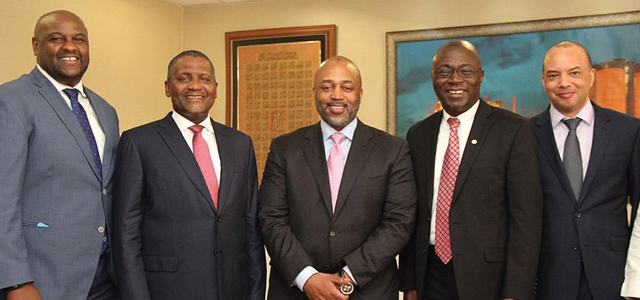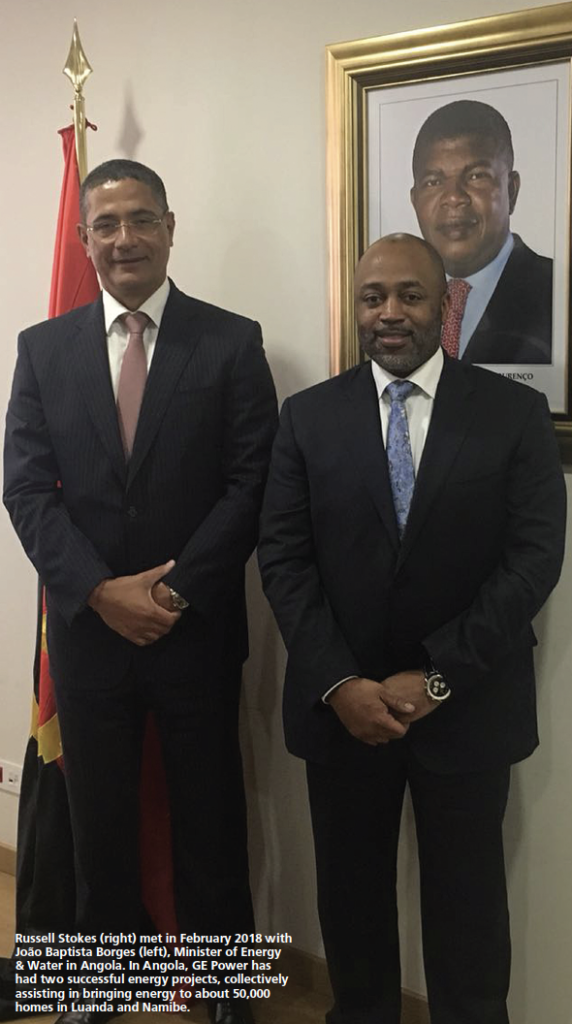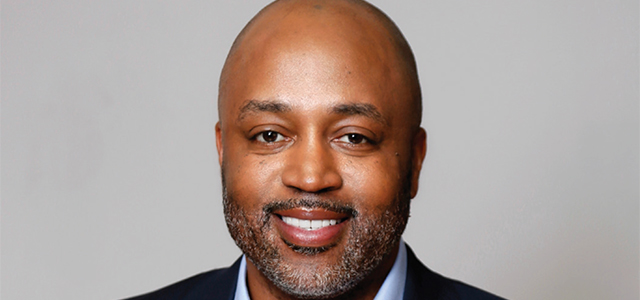As the President and Chief Executive Officer of GE Power and a Senior Vice President of GE (NYSE: GE), Russell Stokes is in the business of bringing power (in the form of electricity) to the people who need it most. “When we at GE say ‘1 billion people on the planet still don’t have access to affordable, reliable power,’ I take it personally,” Stokes says. “We feel a responsibility to help power communities around the world with a focus on delivering outcomes that enable economies and transform lives.”
Stokes was named CEO of GE Power in July 2017 as the company announced the decision to combine the Energy Connections and Power divisions into one, power-focused business. GE’s largest business is GE Power, which provides solutions and services across the entire energy value chain from the point of generation to consumption. Powering more than a third of the world, it serves customers in 180+ countries with nearly 82,000 employees globally, generating $36 billion in revenue last year.
“ When we at GE say ‘1 billion people on the planet still don’t have access to affordable, reliable power,’ I take it personally.”

Russell Stokes (center) and Sub-Saharan Africa leaders met in
February 2018 with Aliko Dangote, CEO of Dangote Group (2nd
from left), which uses GE’s solutions to power its industrial
manufacturing assets.
Bringing Diverse Energy to the World
Global electricity use is expected to rise by 26 percent over the next decade. This is a positive development for the world, because increases in global electricity use have been positively correlated with economic growth, rising living standards, and better health and education. It’s also an opportunity for GE to lead the effort to address the world’s current and future electricity needs in the face of a global recalibration of electricity demand growth. “As a global company operating across the electricity value network from generation to delivery, we can help support this growth anywhere around the world.” Stokes says. “Because of our depth and breadth, no other global player is as well-positioned to compete in this new global environment.” GE has long supported the growing electricity needs in developing regions by partnering with local governments to design electricity systems providing generation from steam turbines, gas turbines or reciprocating engines, and by building out the T&D grid in some cases.
Stokes is particularly passionate about driving the transformation of electricity. Last November, he participated in the International Energy Agency’s (IEA’s) Ministerial Meeting, a key global gathering of top energy officials from 30 member countries and chief executives of the world’s largest energy companies, representing more than $2 trillion in combined market capitalization. The robust dialogue focused on rising renewables penetration, while underscoring the importance of many fuel types to meet global energy demand. “We share this view and need for a diverse energy mix to get power to the people and places that need it most,” Stokes says. “GE is fully committed to the development of the power sector, and we are very engaged with power sector leaders to achieve this end-to-end.”
 GE is also committed to the digitalization of the energy sector. The New York Power Authority (NYPA), the largest state public power organization in the U.S. is embracing digital technology to accelerate its transformation from a one-way centralized grid to a decentralized, intelligent energy network, which IEA advocates. GE has teamed with NYPA to address the disruptive challenge of decentralized energy by creating “digital twins” of customers’ buildings and of NYPA’s many power plants, substations and transmission lines. These virtual assets enable NYPA to monitor its health, performance and needs, which radically improves the company’s operational efficiency and ability to balance supply and demand and meet customers’ needs.
GE is also committed to the digitalization of the energy sector. The New York Power Authority (NYPA), the largest state public power organization in the U.S. is embracing digital technology to accelerate its transformation from a one-way centralized grid to a decentralized, intelligent energy network, which IEA advocates. GE has teamed with NYPA to address the disruptive challenge of decentralized energy by creating “digital twins” of customers’ buildings and of NYPA’s many power plants, substations and transmission lines. These virtual assets enable NYPA to monitor its health, performance and needs, which radically improves the company’s operational efficiency and ability to balance supply and demand and meet customers’ needs.
Stokes says GE is leading by digital example in the power sector. “By digitalizing our own operations, we put ourselves in a better position to help customers like NYPA succeed in their digital efforts – and vice versa,” he shares. “We recently upgraded our largest power monitoring and diagnostic (M&D) center in the world with asset performance management powered by a digital technology called Predix. This M&D center, located in Atlanta, Georgia, monitors the operating health of thousands of turbines and generators around the world for more than 500 power producers and utilities, who in turn provide electricity to more than 390 million people.”
“GE is fully committed to the development of the power sector, and we are very engaged with power sector leaders to achieve this end-to-end.”
Bringing More Power to Africa
In Sub-Saharan Africa, out of 915 million people, 625 million (68 percent of its population) are living without access to electricity, and the number is rising, according to the IEA’s Africa Energy Outlook 2014. Stokes has traveled with other GE executives on many working visits to Africa. Most recently, in February, it was during a time when South African President Cyril Ramaphosa was preparing for his first State of the Nation Address (Sona) and Matshela Koko group executive for generation at Eskom, the State owned utility, resigned. Despite the changing political and utility landscape, Stokes and team were focused on Sub-Saharan Africa and the opportunities to bring efficient and reliable power to the region. “Our goal is to have a better understanding of what we can do; to work with partners – public and private– to provide power for more people,” Stokes shared with the media while there.

Russell Stokes (right) met in February 2018 with
João Baptista Borges (left), Minister of Energy
& Water in Angola.
Across the region, the power dynamics are local and complex, involving almost every fuel type. There are challenges in transmission and distribution infrastructure as well as a critical need for project execution and financing capabilities. South Africa is tapping into its local, indigenous fuel sources to bring reliable, available and cleaner power to its grid with the goal of bringing electricity to 95% of the local population by 2030. “In countries, such as South Africa, blessed with significant coal resources, there is a need to appreciate coal in the total energy mix,” Stokes stated. Thanks to the latest steam technology that brings higher efficiency while lowering emissions, GE has been selected to support the country on its energy development in the two largest dry-cooled coal power plants in the world: Medupi and Kusile. Stokes held a media briefing in Pretoria ahead of a visit to the Kusile coal plant under construction by Eskom near eMalahleni (Witbank) in Mpumalanga.
In Ghana, GE is working with Marinus Energy on a pilot project to capture Isopentane gas and use it as a fuel source for generating electricity. The Atuabo Waste to Power Independent Power Project (Atuabo) will be the first TM2500 power plant in Sub-Saharan Africa to use Isopentane gas as a fuel source, generating enough electricity to supply power for more than 100,000 Ghanaian households.
There is growing demand for power in Angola. GE and the Angola Ministry of Energy and Water signed a Memorandum of Understanding (MoU) in 2014 to help achieve the country’s additional electric power generation and implemented the GE Power for Angola program. Today, the program delivers energy solutions across the entire energy ecosystem for Angola’s national development, from generation to transmission and distribution as well as long term service guarantees. GE remains committed to supporting Nigeria in providing access to the 80 million people without electricity. Stokes and the power team are working with the government and private sector to provide an end-to end solution for ensuring that power generated is transmitted and available for consumption.
“ Our goal is to have a better understanding of what we can do; to work with partners – public and private – to provide power for more people.”
Bringing Growth to Metro Atlanta
While fully committed to his role as CEO of GE Power, Stokes finds it equally important to support his local community. As the 2018 Chairman of the Metro Atlanta Chamber (MAC), Stokes is in the service of bringing growth (in the form of jobs and technology) to a community that fosters innovation. “The Atlanta region is evolving from an industrial to a digital economy. We have the jobs of tomorrow, and we are producing talent for those jobs today,” he says.
MAC’s 2018 priorities include multiple initiatives, such as workforce development and new job recruiting strategies, emphasizing economic mobility and a new digital platform to engage young professionals to move and start their careers in the region. To advance economic growth and improve metro Atlanta’s quality of place, Stokes is overseeing MAC’s focus on starting, growing and recruiting companies to the 29-county metro Atlanta region. The Chamber is also focused on growing the region’s innovation economy by promoting and strengthening connections to drive Atlanta’s innovation and entrepreneurial culture.
MAC selected Stokes to chair the organization’s board in 2018 and David Abney, Chairman and Chief Executive Officer of UPS, to chair the board in 2019. Stokes has been a member of the MAC Executive Committee for the last two years. Metro Atlanta Chamber spokeswoman Deisha Barnett said the chamber is excited about Stokes’ promotion. “Russell’s scope of responsibility is expanding, and he’ll do it all from Atlanta,” she said. “Good news, all around.”
Jeffrey C. Sprecher, 2017 MAC Chair, Chairman and Chief Executive Officer of Intercontinental Exchange and Chairman of the New York Stock Exchange, stated, “Russell and David represent what we call the ‘Atlanta Way’. They are strong corporate and philanthropic leaders with an unwavering commitment to expanding the reach of our vibrant and growing Metro Atlanta region. We are fortunate that they are leading organizations that are major contributors to our region’s economy. Their business acumen and perspective will be invaluable over the coming years as we continue to drive unprecedented growth that furthers metro Atlanta’s position as a top-tier global region.”
Metro Atlanta and the state of Georgia continue to dominate in a range of industries, including in business and economy, infrastructure, supply chain, digital and IoT [internet of things], workforce and quality of life,” according to the Chamber. At the start of 2018, MAC released updated rankings for the metro region and state reflecting progress made in the previous year. The rankings highlighted Atlanta’s reputation as a place to invent, connect, inspire and thrive. The rankings also demonstrated the continued growth of a metro that is a “top tech mecca, the destination for leading centers for education, home to the world’s most-traveled airport and the location with a quality of life that is second to none.”
“The Atlanta region is evolving from an industrial to a digital economy. We have the jobs of tomorrow, and we are producing talent for those jobs today.”
Stokes has been very active in Atlanta since his arrival in 2015. He serves on multiple boards, including the Atlanta Committee for Progress, a partnership between the city’s top business, civic and academic leaders and the Mayor of Atlanta to support positive change; the Atlanta Junior Achievement Executive Committee, inspiring and preparing young people to succeed in a global economy through programs, which impacted 175,000+ students during the 2016-17 school year; and Usher’s New Look, a non-profit organization founded by Usher Raymond IV to transform the lives of underserved youth through a 10-year comprehensive program to develop passion driven, global leaders.
More about Russell Stokes
As a 20-year GE veteran, Stokes has a wide range of GE leadership experience in addition to his deep industry, company and customer knowledge. Prior to leading GE Power, he was the President and Chief Executive Officer of GE Energy Connections, the electrification, grid and controls business of GE. He also served as the President and Chief Executive Officer of GE Transportation, a global leader in rail, mining and marine industries.
Stokes has held numerous leadership positions in finance, operations and services within GE Transportation, GE Aviation and GE Lighting. He started his career in sales for a PC manufacturer before joining GE. He graduated from Cleveland State University with a degree in Finance, and he completed GE’s Financial Management Program.



